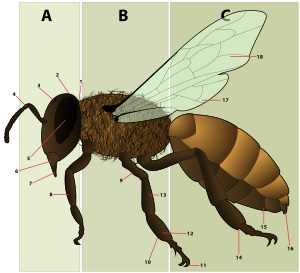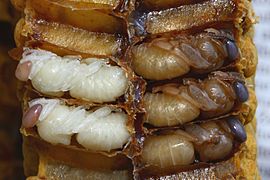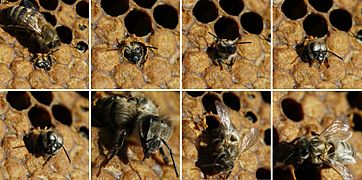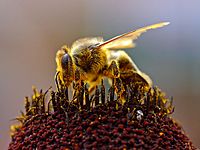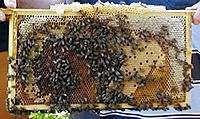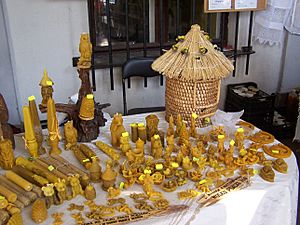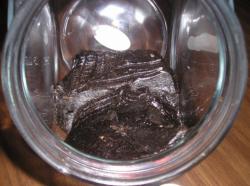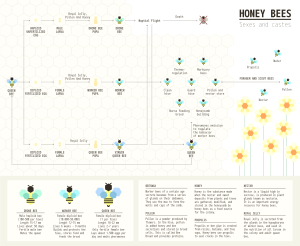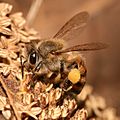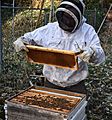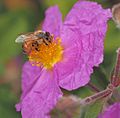Honey bee facts for kids
Quick facts for kids Honey bees |
|
|---|---|
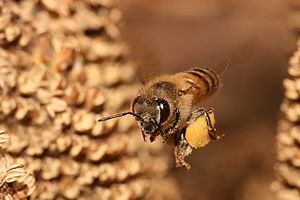 |
|
| European honey bee carrying pollen back to the hive | |
| Scientific classification | |
| Kingdom: | |
| Phylum: | |
| Class: | |
| Order: | |
| Family: |
Apidae
|
| Subfamily: |
Apinae
|
| Tribe: |
Apini
|
| Genus: |
Apis
|
| Species | |
|
|
A honey bee is a type of bee that belongs to the group called Apis. These amazing insects are known for making and storing honey. They also build their homes, called nests, out of beeswax. Unlike some other bees, honey bees live together in large groups, called colonies, all year round.
Honey bees are the only living members of their special group, or tribe, called Apini. There are seven different kinds, or species, of honey bees, and a total of 44 smaller groups called subspecies. Even though there are about 20,000 known species of bees, only those in the Apis group are true honey bees. Studying honey bees is called 'melittology'.
The oldest honey bee fossils we've found are about 34 million years old. They were found in Europe, which tells us bees were there a long time ago. However, scientists think honey bees first came from South Asia. Before Europeans brought A. mellifera to the New World (North and South America), there were no Apis species there. Only one fossil honey bee, about 14 million years old, has been found in Nevada.
Honey bees are related to bumblebees and stingless bees. These relatives also live in groups, but not quite like honey bees do.
Contents
Where Honey Bees Come From
Scientists believe honey bees first appeared in South and Southeast Asia, including the Philippines. This is because most honey bee species, except for the European honey bee (Apis mellifera), are originally from that area. The oldest types of honey bees still alive today, Apis florea and Apis andreniformis, also come from this region.
The very first Apis bee fossils were found in Europe and are about 34 million years old. This doesn't mean Europe was where they started, but it shows they were living there by then. We don't have many fossils from South Asia, where scientists think honey bees truly began.
No Apis species lived in the New World before Europeans brought A. mellifera there. The only fossil of an Apis species found in the New World is Apis nearctica, a 14-million-year-old bee found in Nevada.
Honey bees are related to other social bees like bumblebees and stingless bees. Living in groups is an old trait that was around even before the Apis group formed. The older types of honey bees build single, open honeycombs. The newer types build their nests inside hidden spaces and have many combs. This made it much easier for humans to keep them.
Most honey bee species have been used by people for their honey and beeswax in their native lands. However, only two species have been truly tamed by humans: the European honey bee (Apis mellifera) and Apis cerana indica.
Today's honey bees are divided into three main groups: Micrapis (dwarf honey bees), Megapis (giant honey bees), and Apis (which includes domesticated honey bees).
How Honey Bees Live: Their Life Cycle
Honey bee colonies usually have one queen bee, who is a female that lays eggs. They also have thousands of drone bees, which are male bees, and tens of thousands of worker bees, who are sterile females. Here's how their lives work:
- Eggs and Larvae: The queen bee lays a single egg in a wax cell built by worker bees. She can choose to fertilize the egg or not. Unfertilized eggs become male drones. Fertilized eggs become female queens or worker bees. Young bees, called larvae, are first fed a special food called royal jelly by worker bees. Later, they eat honey and pollen. The only exception is a larva that will become a queen; she eats only royal jelly. The larva grows, sheds its skin several times, then spins a cocoon and turns into a pupa.
- Young Workers: Young worker bees, sometimes called "nurse bees," clean the hive and feed the larvae. As they get older, they start building honeycomb cells. Then they do other jobs inside the hive, like taking nectar and pollen from bees returning from outside, and guarding the hive. Later, a worker bee takes her first practice flights and then spends the rest of her life collecting food outside the hive.
- Communicating for Food: Worker bees work together to find food. They use a special "dancing" pattern, called the waggle dance, to tell each other where good food sources are. This dance is a bit different for each honey bee species, but all Apis species do some form of it. If food is very close, they might do a simpler "round dance."
- Recruiting Help: Honey bees also do "tremble dances" to get other bees to come and collect nectar from bees who have just returned to the hive.
- Queen Mating: Young queen bees fly away from their home hive to special areas where many male drones gather. They mate with several drones before returning. The drones die after mating. Queen honey bees do not mate with drones from their own hive.
- Starting New Colonies: New honey bee colonies are started by groups called "swarms." A swarm includes a mated queen and many worker bees. This group flies together to a new nest spot that worker bees found earlier. They tell each other where to go with a special dance. Once the swarm arrives, they immediately build new wax combs and start raising new young bees. This way of starting a new nest is unique to honey bees.
Life cycle
-
A colored dot applied by a beekeeper identifies the queen
Pollination
Honey bees visit many different kinds of flowering plants and help them grow by pollinating them. Of all the honey bee species, only A. mellifera is widely used by people to pollinate fruit and vegetable crops. This help is worth billions of dollars worldwide, adding about 9% to the value of crops. While honey bees are very important for crops, some people wonder if they compete with the 20,000 other types of wild pollinators in natural areas. Bees collect about 66 pounds (30 kg) of pollen each year for every hive.
Nutrition
Honey bees get all the food they need from a mix of pollen and nectar. Pollen is the only natural source of protein for honey bees.
Pollen also gives honey bees fats, which are important for young bees to grow. They also get vitamins from pollen. Honey bees eat special plant fats from pollen to make other fats they need, because they can't make them on their own. Nurse bees can pass these fats to the larvae they feed.
Nectar is gathered by worker bees. It gives them water and sugar (carbohydrates). Adult worker bees need about 4 milligrams of sugar each day. Young bees need about 59.4 milligrams of sugar to grow properly.
Honey bees also need water to stay healthy, to make liquid food for young bees, and to cool down their hive when it's hot. Nectar usually has enough water, but on very hot days or when nectar is scarce, bees will collect water from streams or ponds.
Beekeeping
Two types of honey bees, A. mellifera and A. cerana indica, are often kept, fed, and moved around by people called beekeepers. Modern beehives allow beekeepers to move bees from one farm field to another as crops need pollinating. This lets beekeepers charge money for their pollination services. This has changed beekeeping from a small, local job to a larger business.
Colony Collapse Disorder
Since 2007, many European honey bee colonies in North America have been dying off at unusually high rates (30–70% of hives). This problem is called "colony collapse disorder" (CCD). Scientists believe it's caused by several things working together, rather than just one disease or harmful chemical. These might include certain types of pesticides or viruses.
Bee Products
Honey
Honey is a sweet, thick substance bees make by collecting nectar, processing it, and storing it in honeycombs. People all over the world have gathered honey from all living Apis species for eating. Only honey from A. mellifera and A. cerana is collected for selling in stores.
Beeswax
Worker bees of a certain age produce beeswax from special glands on their bodies. They use this wax to build the walls and caps of their honeycomb cells. Like honey, beeswax is collected by humans for many different uses.
Pollen
Bees collect pollen in special "baskets" on their legs and bring it back to the hive. Inside the hive, pollen is used as a source of protein for feeding young bees. In some places, extra pollen can be collected from A. mellifera and A. cerana hives. People sometimes eat it as a health supplement. It has also been used to help pollinate plants by hand.
Bee bread
Worker bees mix pollen, honey, and special liquids from their bodies. They let this mixture ferment in the comb to make "bee bread." This process helps release more nutrients from the pollen and can create things that stop it from spoiling. Nurse bees (younger workers) eat bee bread. This helps them produce the protein-rich royal jelly needed by the queen and developing larvae.
Bee brood
"Bee brood" refers to the eggs, larvae, or pupae of honey bees. It's very nutritious and is considered a special food in countries like Australia, Indonesia, Mexico, Thailand, and many African countries. People in ancient China, Egypt, and Mayan civilizations also ate it.
Propolis
Propolis is a sticky, resin-like mixture that honey bees collect from tree buds, sap, or other plants. They use it to seal up unwanted open spaces in their hive. Some people say propolis has health benefits (like helping with colds), but there's no strong scientific proof, and it can cause bad allergic reactions in some people. Propolis is also used in wood finishes, and it's said to give Stradivarius violins their special red color.
Royal jelly
Royal jelly is a special food made by honey bees to feed their larvae. It's the only food a queen bee eats throughout her life. Like propolis, it's sold for supposed health benefits, but these claims are not proven, and it can also cause severe allergic reactions in some people.
Bee Family Roles: Queens, Workers, and Drones
Honey bees have three main types, or castes, in their colony: drones, workers, and queens. Drones are male, while workers and queens are female.
Drones
Male bees, called drones, usually have only one set of chromosomes. Their main job is to mate with the queen. They are born from eggs that the queen doesn't fertilize, or sometimes from unfertilized eggs laid by a worker bee. Drones take 24 days to develop. They are usually found in the hive from summer to autumn, with as many as 500 per hive. During winter, when the hive needs to stay warm and save food, drones are kicked out. Drones have large eyes to help them find queens during mating flights. They do not defend the hive or sting intruders because they don't have a stinger.
Workers
Worker bees have two sets of chromosomes. They come from eggs that the queen has fertilized using stored sperm. Workers usually develop in 21 days. A typical colony can have up to 60,000 worker bees. Workers do many different jobs throughout their lives. Their duties change as they get older: they start by cleaning their own cell after hatching, then feed young bees, receive nectar, clean the hive, guard the hive, and finally, collect food outside. Some workers have special jobs, like removing dead bees from the hive.
Workers have special body parts for their jobs, such as the pollen basket (a special area on their leg for carrying pollen), glands on their belly that make beeswax, and glands for feeding young bees. Their stingers have small barbs. If a colony loses its queen, some worker bees might start to lay eggs, but these eggs will only become drones.
Queens
Queen honey bees are created when worker bees feed a single female larva only royal jelly. Queens grow in larger cells and develop in only 16 days. They are different from worker bees in their body, how they work, and their behavior. Queens are bigger than workers and have working ovaries. They also have a special sac called a spermatheca, which stores sperm after they mate. Apis queens mate with many males. For example, Apis nigrocincta queens have been seen mating with a very high number of drones, from 42 to 69! A queen's stinger is not barbed like a worker's, and queens don't have the glands that make beeswax. Once a queen has mated, she can lay up to 2,000 eggs each day. She also produces special chemicals called pheromones that control the behavior of the worker bees and help swarms follow her.
Defense
All honey bees live in colonies where the workers sting intruders to defend their home. When bees are alarmed, they release a special smell (a pheromone) that tells other bees to attack. Honey bee workers are different from almost all other bees because their stingers have small barbs.
The stinger and the venom sac of worker honey bees are designed to pull free from the bee's body once it's stuck in something. The stinger even has its own muscles and nerves, so it keeps delivering venom even after it's detached. The gland that makes the alarm pheromone is also connected to the stinger. The stuck stinger keeps releasing more alarm pheromone, which attracts other worker bees to the sting site. The worker bee dies after its stinger gets stuck and tears away from its body. The honey bee's venom, called apitoxin, has several active parts, with melittin being the most common and phospholipase A2 being the most harmful.
How bees defend themselves can depend on where they live. For honey bee species with open combs (like A. dorsata), they give a warning signal to predators. This signal looks like a "Mexican wave" that spreads across the bees packed on the comb's surface. The bees quickly arch their bodies and flick their wings. For species that live in hidden spaces, like Apis cerana, Apis mellifera, and Apis nigrocincta, they guard the entrances to their nests and check incoming bees for intruders. Another way they defend against invaders, especially wasps, is by "body shaking," where worker bees violently sway their bodies back and forth.
Gallery
-
Eastern honey bee (A. cerana) in Hong Kong
Images for kids
-
The European honey bee may have originated from eastern Africa. This bee is pictured in Tanzania.
-
Western honey bee on rock rose (Cistus) in Oakland, California
-
Western honey bee collecting pollen from turnip blossoms in Eastern Oklahoma
See also
 In Spanish: Apis (género) para niños
In Spanish: Apis (género) para niños



